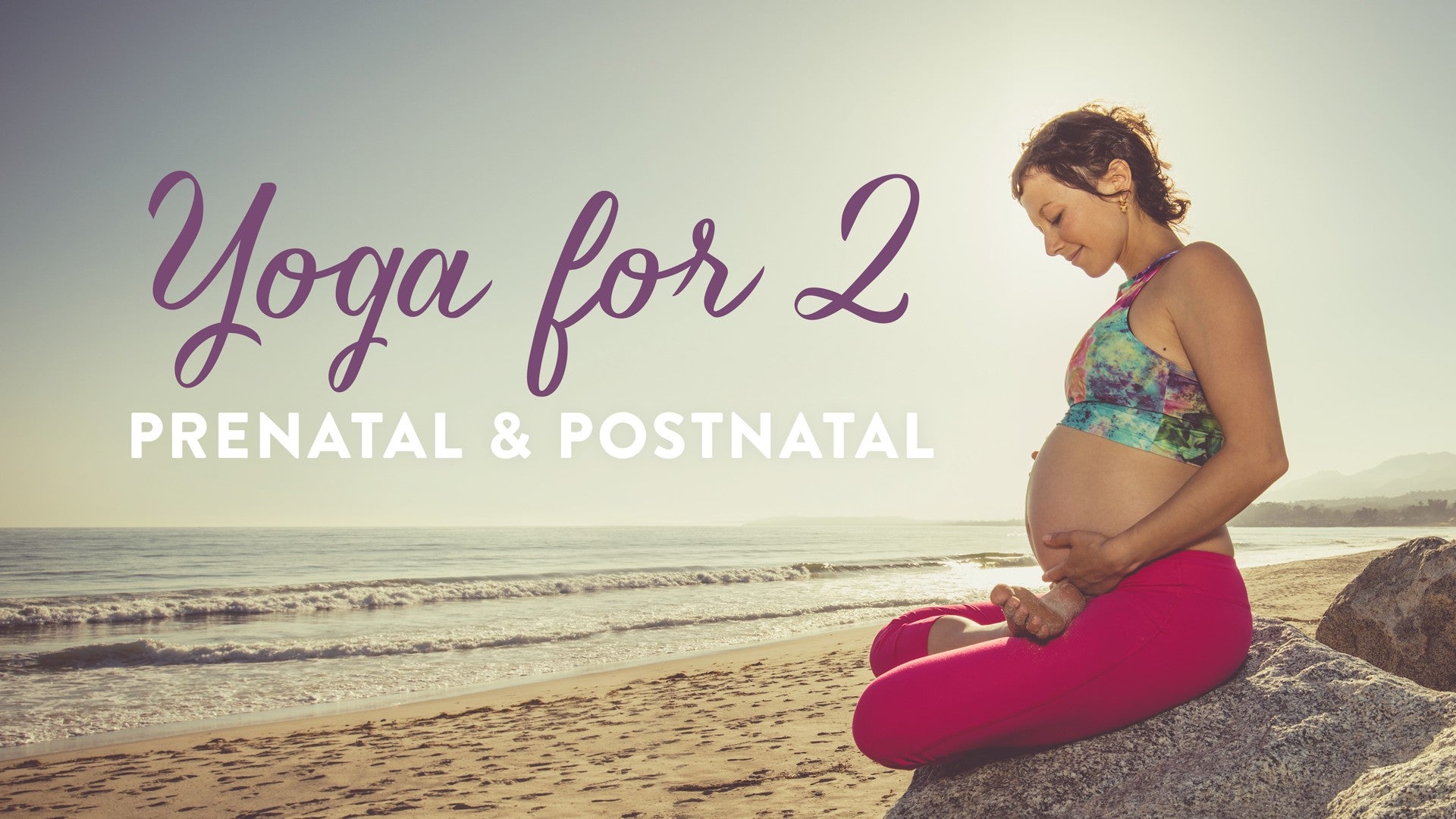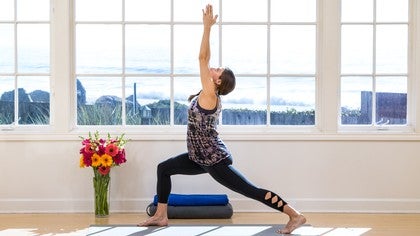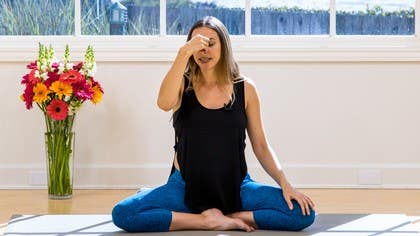Description
Transcript
Read Full Transcript
So welcome. In this episode we're gonna be breaking down sun salutations A and B. So I'm gonna give lots of options for moms as you're growing. So in the beginning you may be able to do a sun salutation more similar to what you were doing before pregnancy, but as the baby starts to grow, the belly starts to stretch, you may have to tone it back, and so I'm gonna give you some options for how you can do that, and then you can continue to flow throughout the whole pregnancy. So we'll come to standing.
And we're gonna come to the back of our mat, and we'll just take our feet about hip distance. As the belly gets bigger we're gonna have to go even a little wider, so just a comfortable distance between your feet. And roll the shoulders down the back, and we'll just slightly gaze forward, soft gaze. And just start to focus on your breathing, in and out through the nose. And as you breathe, really let the ribcage expand in all directions.
And let the belly relax. So whereas before pregnancy we may have focused on lifting up the lower belly, now we just totally let it relax. And if you have a tendency to tilt the pelvis forward too much, which can compress the lower back, then you'll wanna just slightly lengthen the tailbone. But still not try to engage too much in the belly. So the diaphragm can fully drop down.
And then we'll take this into half sun salutations, which are always an excellent way to warm up. Inhale, you'll reach the arms out to the side and up overhead. For me it's comfortable to bring my hands together, but if that causes shoulder tension, neck tension, then just keep the hands apart. With your exhalation you can soften the knees as you fold forward, and just let the hands come down alongside the shins, back of the head and neck relax and look through the legs. Inhalation, bring the hands to the fronts of the shins, even the knees, coming up as much as you need to, to really lengthen the spine and create that anterior tilt.
So rather than tucking the pelvis under, we really wanna tilt the pelvis forward. Exhale, you'll fold down again, lengthening the back of the neck. Gazing through the shins. Inhale, look up, come all the way up, reaching the arms up overhead. Maybe bringing the hands together or just keeping them shoulder distance apart.
And exhale, arms down alongside the body. Repeating, inhale, reaching the arms. Exhaling, hinging at the hips, softening the knees as needed to forward fold. Head and neck relax. Inhale, looking up and lengthening, coming up halfway.
Exhale to fold again. Inhale coming up all the way, reaching the arms up overhead. Reaching high, lengthening the side bodies. And exhale, arms down alongside the body. And one last time, inhale, we'll reach the arms up overhead.
Exhale, hinging at the hips and folding forward. Inhale, look up and lengthening. And this time as you exhale, you'll bend your knees, bring your hands to the floor, and we're gonna walk them forward, to downward-facing dog. For the first one just bend your knees a little, keep the heels lifted, and the right away we're gonna bring our knees down to the floor. So that we're on hands and knees for a little cat cow.
Now cat cow is an excellent option for all of our transitions so rather than doing plank to Chaturanga and up dog you can always use cat and cow. And if it feels like the belly is stretching too much, for some women the muscles will start to separate, as we move further along into pregnancy. Then just taking a gently cat cow is really a good option. So not even exaggerating the backbend, but just pulling the upper arms back, the chest forward, and then exhaling, tucking the tailbone under. You can do this with your toes curled under or pointed.
Inhaling, lifting the chest. And exhaling. Rounding. And inhaling, lifting the chest. Once again, exhaling, rounding, and emphasize more the rounding in the upper back.
And same with the backbend, more in the upper back than anywhere else. Especially if you have a tendency to be hypermobile. With your next exhalation we'll curl the toes under again lift the hips up and back for downward-facing dog. And for downward-facing dog feel free to bend the knees so that you can keep the pelvis facing forward. And another option is just to come to child's pose, where you point your toes, sit the hips back towards your heels, and let the head and neck relax.
We'll stay there for about five breaths. Three. Four. And five, then we'll walk the hands back towards the feet, inhale, bending the knees if you need to, look up and lengthen. Exhale, fold.
And inhale, come all the way up, reaching the arms up overhead. And exhale, arms down alongside the body. Inhale, arms reach. Exhale and fold forward. Inhale, look up and lengthen.
Exhale, bend your knees again, set your hands down, walk them forward to downward-facing dog. From downward-facing dog, we can come to plank, this is a great option. If you'd still like to work on some of the strength and stamina, but you're not looking to get any more stretch in your belly, and then exhale, you can just press back to downward-facing dog. Or child's pose. Hold and breathe, that's one.
Two and you may find you wanna bring your feet a little wider apart, it's perfectly fine. Three, even turning the toes in a little bit can help. Four. Pressing the floor away from you to lengthen your side bodies. And five, and then we'll just walk the hands back towards the feet.
Inhale, look up and lengthen. Exhale, fold. And inhale, come all the way up. Reaching up overhead. And exhale.
Returning to Samasthiti. One more time, inhale, arms reach. Exhale, hinge at the hips and fold. Inhale, look up and lengthen. Then again, exhale, bend your knees, set your hands in front of you, walk them forward.
For this next one, more like a traditional sun salutation, we'll inhale, bring the shoulders forward, like plank, exhale, you can bring your knees down to the floor, point the toes and lower. From there you can go right to cobra, or drop the hips, pull the shoulders back, lift the chest, and maybe it's here. And then exhale, curl the toes under, press the hips up and back. Downward-facing dog, breathe, can also be in child's pose. After your fifth breath, again, walking the hands back towards the feet, inhale, look up, lengthen.
Exhale, fold. And inhale, come all the way up to standing. And exhale, arms down alongside the body. And we'll step to the front of the mat now. We're gonna do another sun salutation A, more traditional stepping back, but walking the hands forward is definitely a little gentler, so if this is too much, just repeat how we were doing them previously.
Any of those options are great. Inhale, arms reach. Exhale, fold forward. Inhale, hands to the shins or knees, look up. Exhale, bend your knees, set your hands down in front of the feet, step back.
You can step to down dog. Then come forward to plank. Exhale, lower. Inhale, up dog, knees can come to the floor if necessary. And exhale back, downward-facing dog.
Breathing. End of your fifth breath look forward, walk your feet to your hands. Taking as many steps as you need, inhale, look up, lengthen as you land. Exhale, fold. And inhale, come all the way up, reaching up overhead.
And exhale, returning back to Samasthiti. I'll start sun salutation B, so let's step back to the back of your mat again. Feet again at least hip distance apart for Utkatasana. So chair pose, we'll sit the hips back like we're sitting into a chair, take the shins back, inhale, circle the arms up overhead, they can be apart, or some of you might wish to bring the hands together. Exhalation we're gonna fold forward.
Inhale, hands to your shins, look up, lengthen. And then again, exhale, bend your knees, set your hands flat, walk them forward to downward-facing dog. From downward-facing dog, we're just gonna bring the knees down to the floor, and then from there maybe come to your fingertips, and step your right foot forward, just behind your hand, and maybe a little further out to the right. This gives you plenty of room for your belly. Now we're just gonna come into a low lunge.
So this could be your option especially if your heart rate is really picking up, you can also add the arms, reaching the arms up, so nice low lunge. Some of you may wanna just keep your hands on your knees for stability and support, or hands at the hips. To make it a little bit more of a stretch for the hip flexor you can bend into it, just be careful not to let the knee go past the ankle, so if you're gonna take that option, just step the foot forward a little further, and then sink the hips. And then from there we're just gonna bring the hands down to the floor, step back, take a little cat cow, inhale. Exhale.
And then we'll take the left foot forward. Step it down, bring your hands to your knees, one option. Or inhale, reach the arms all the way up, reaching high, hands can be apart or together. And then if you're gonna take a little deeper into the lunge, just slide your foot forward, and then bend. From there we'll release the hands down to the floor, step the left foot back, inhale.
Opening the chest through the upper arms. Exhale, rounding the back. And then curling the toes under, and with your next exhalation, pressing back to child's pose or downward-facing dog. And breathing there. And we'll walk the hands back to the feet, bending your knees as needed.
Inhale, look up and lengthen. Exhale, and fold. And we bend our knees, sit the hips back, inhale to chair pose, and exhale, Samasthiti. Bend your knees, sit your hips back, inhale. Exhale, fold.
Inhale, lengthen. Exhale, bend the knees, set the hands, walk them forward. To down dog. Then inhale if you'd like, you can take your plank Chaturanga up dog, or any of your options, cat cow, plank to down dog. Exhale, down dog.
From here we'll bring the feet together. On an inhale, we'll raise the right leg up and back. Let the hip open if you'd like. Really stretching out the back of the left leg, opening the right hip socket. And then squaring the hips off again towards the floor, and stepping the right knee forward, and stepping it just behind the right hand, maybe a little more out to the right.
Now coming up from here can get a little challenging as the belly's bigger, if you need to, bring the knee down first. Otherwise you can take your right hand to your right knee and help press yourself up to crescent. From here, relax the arms down. You may wanna stay right here, or inhale, reach the arms up, maybe bring them together if it's appropriate. And then exhale, we'll release.
Bring the hands down, you can use your right hand on your knee for support. Set the hands flat and then step back to down dog. From down dog if you'd like to take your transition, inhale to plank. Exhale. Inhale.
And exhale back. And then we'll bring the feet together again. With inhalation raise the left leg up and back. Again if you wanna open up the hip, just to get a little more range of motion in the hip socket go ahead. And then we'll square the hips off again, and we'll step the left foot forward.
If needed, bring the right knee to the floor to come up, balance can get challenging as our center of gravity shifts, otherwise bring the hand to the knee, press yourself up into a high lunge, and then maybe reach the arms up for crescent. With exhalation we'll bring the hands down. And step back to down dog. Option to take your transition, inhale, come forward. Exhale, lower.
Inhale, up dog. And exhale, down dog. And then breathing in down dog. And your fifth breath, walk your hands back, inhale, look up, lengthen. Exhale, fold.
Bend your knees, sit your hips back, inhale to Utkatasana. And exhale, Samasthiti. The last one we're gonna take more like a traditional Surya Namaskara B. So we'll walk to the front of our mat, still keeping the feet a little wider than normal. Bend your knees, sit your hips back, inhale.
Exhale, fold. Inhale, lengthen. Exhale, bend your knees, set your hands flat in front of your feet, step back to down dog. Then from there we're gonna step the right foot forward, a little more to the right than we normally would. And if you need to raise the leg up go ahead.
Otherwise just go for it. This time we'll pivot the back heel down. Now here you wanna be in a little wider of a stance, so definitely not on a tight rope, give yourself a wider base for balance. Bend your right knee, pull the right hip back, left hip forward, if you need to use a support. Bring your hand to your right knee to lift yourself up.
We'll take the arms up overhead. And with exhalation, bring the hands down to the floor. And press back to down dog. From down dog you can come forward to inhale, plank, exhale, lower. Inhale.
And exhale. Second side, if you need to bring the feet together, then raise the left leg, otherwise, just step your left foot forward. Stepping it more to the left than you usually would, pivot the right heel down. If you need to, use your left hand on your left knee for support, and inhale up. Warrior I.
Exhale, bring the hands down. Step back, downward-facing dog. Inhale if you'd like, come forward. Exhale, lower. Inhale, cobra or up dog, or cat cow.
Exhale, down dog. And breathing. And from downward-facing dog, we're gonna bring our knees to the floor and come to seated, so we'll just take the knees down to the floor and it's a good idea to grab a blanket or a bolster. We're gonna come to an easy seat Sukhasana. So I'm gonna use a blanket, if you need, you might need two or even a bolster.
Prop yourself up. The reason is, we really do want to create that upright pelvis, so imagining the pelvis, like a bowl and we don't want it to be tucked under. If anything while we're pregnant, we want to start to encourage the pelvis to come forward a little bit without exaggerating it, of course, if that's your natural tendency. If you exaggerate it too much you're gonna get tension in the low back. But we often talk about creating like a hammock for the baby to rest in, so just tilting the pelvis forward or at least upright.
And for some of us it requires that we elevate the hips a bit in order to achieve that. So you can either keep the ankles crossed, the feet flexed, that's dorsiflexed, or for me I actually prefer to take my knees a little wider, this gives me more space, and point my toes, and then the heels are either right one in front of the other, or even a little wider, and then from there just letting the pelvis tilt forward, you can rest with your hands at your knees and just close the eyes. And we're gonna take 10 breaths on either side. I'm gonna give you another option to just bring your hands to the floor and with the hands both pressing down so the sit bones stay rooted, but also letting the chest kind of fold forward. Now depending on how big your belly is at this point, you're gonna be able to fold, you know, to wherever you can fold.
And just setting wherever you stay for 10 breaths, it's one. Two, really focusing internally. Three, relaxing any tension in the shoulders, in the breath, and most importantly, in the mind. Four. Five.
Six. Seven. Eight. Nine. And 10, and if you folded forward, you'll walk your hands back.
And we'll just switch the cross in the legs or ankles. And either sitting upright here or bringing the hands forward, 10 more breaths on the opposite side. So keeping your sitting bones rooted, but also lengthening forward, if that's appropriate for you at this stage, it's one. You can kinda close the eyes so that you can really focus internally, two. Really starting to focus the mind on the breath.
Three, and if you notice it drifting off into any thoughts, bringing it back to the breath. Four. That way we're really practicing our concentration. Five. We're practicing where we want to focus.
Six. Seven. Eight. Nine. And 10, then walking your hands back, and we'll set up for our Shavasana.
So unless you're in the very beginning of your pregnancy, first trimester, you probably don't wanna lay on your back, it'll be more comfortable for you to take a supported Shavasana on your left side. So you can use a blanket under your head as a pillow, I'm gonna use my blanket as support for my belly. And then my bolster between my legs. So I'll scoot down, this blanket is lined up so that it'll cradle the underside of my belly. The bolster will go between my legs, mainly because the hips, I've always had wider hips, but also when you're pregnant, a lot of times, they will widen, so to give yourself that extra support so that you don't have that strong QL angle, will be more comfortable for this hip socket.
And then we wanna lay on the left side so that we don't cut off the venous return of the blood flow to the heart. So it's important for your health and also the health of the child, so that they can get fresh, oxygenated blood throughout your entire extremities, and then you'll just lie down on your side. And I use my arm as my pillow, and then also you can think about, if you find that you're rolling back, you can actually bring the left leg back a little, let the right hip and right leg lean forward, and then your belly will kind of fall into the blanket nicely, and we'll stay here for about three minutes, but feel free to rest as long as you need, or as long as you'd like, really taking the time to nourish yourself in Shavasana. Ending your practice for the day. And just closing the eyes, settling down, settling in.
Letting the breath be nice and relaxed and calm. Zero effort. So of course you can stay here as long as you'd like. If you'd like to come along with me, I'm gonna get up, so you can just press your right hand down, use that for support to bring yourself up. You can remove the bolster, you can even stack it on top of your blanket.
I'll just come to a comfortable seated position. If you need to, sit up on your blanket and bolster. We'll just bring the hands to prayer position at the heart. Gently bow the head in gratitude for all the blessings in life. Blessings of your baby, of your body, of the opportunity to be here now, the journey ahead, and thank you all for joining me today.
Namaste.
Yoga for 2: Prenatal and Postnatal: Active Prenatal
Comments
You need to be a subscriber to post a comment.
Please Log In or Create an Account to start your free trial.












